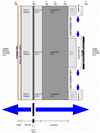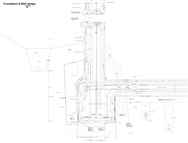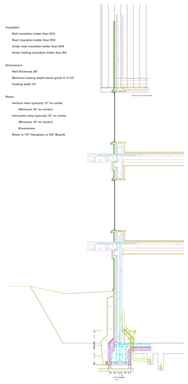Home Site Map - Techniques - Building Science -
Foundation and Wall Design
![]() The perfect wall built on mono-pour footings and slab.
The perfect wall built on mono-pour footings and slab.
My particular wall design
The top level building science on wall design is covered on the previous page, but it's worth talking about some of the details my particular wall design.
Vapor barrier sandwiched between insulation
You can see my wall design and how it dries in the diagram below. The vapor barrier is part way through the insulation. Neither side of it is a particularly cold surface, so this reduces the likelihood of condensation. There is actually about 1.5 times as much insulation on the external side of the vapor barrier compared with the inside which is appropriate given that I'm in a northern climate (Seattle). In practice, because EPS in sufficient thickness will stop most of the water vapor, it is ok to leave off the actual polyethylene vapor barrier when the wall is above ground, but it is still good to assume a virtual vapor barrier in the place shown in the diagram.

Drainage plane
A drainage plane is the first in line defense against rain water. You want the majority of the rain water to run away rather than soak into the wall. It does not matter much if it does soak in as it won't get past the 6 mil polyethylene vapor barrier, and it will easily dry (to the outside), but even so, if it's easy to make it drain straight away then this is goodness. The primary drainage plane in my wall design is the outer stucco surface. The stucco is fashioned to look like brick (2-1/4" x 8" brick size), and the grooves do reduce the water drainage a bit.
To further increase the water shedding ability, you can paint on a water repellant product. You are best using a transparent water repellant sealant that soaks in. Do not use a sealant that forms a film on the surface because you want the wall to still be able to breath out water vapor. A soak in water repellant can be found here .
In the Building Science paper that can be found here there are 3 strategies for keeping rain from penetrating walls. The classifications are "Perfect barriers", "Mass or storage systems", and thirdly "Screened and drained walls ". In the definitions of wall types presented in the paper, my wall is a "perfect barrier" design with that "perfect barrier" being the outside layer of stucco. As a backup strategy it also provides an inner "perfect barrier" which is the 6 mil polyethylene sheet in case the external "perfect barrier" ever becomes slightly imperfect. Even the EPS sheeting can also be regarded as another backup "perfect barrier". Note that "perfect barrier" designs do not require a drainage air gap inside the wall.
The concrete effect
The concrete in the wall is 8 inches thick (the dots in the diagram are the inch markers), but concrete is primarily a thermal conductor rather than a thermal insulator. What's more, the concrete will be heated by the house central heating system so it's temperature will be fairly close to the temperature inside the house. Even though concrete is not a thermal insulator it does have beneficial effects in that it is a huge thermal mass. A thermal mass that is closely connected to your inside living space will help you keep cool in the summer by releasing the cool of the night during a hot sunny day and will help keep you warm on winter nights.
Winter holiday extreme example for my wall design
If you have been out of the house visiting friends or relatives for a week over the winter holidays and then as soon as you come home you start boiling pasta and soaking in a hot steamy bath then you will get condensation on your inside walls. The reason of course is that without the heating on in the house while you were away, the concrete in the walls will have cooled down to the outside winter air temperature. It will take quite a few hours to heat up the walls, even if you turn your heating up full blast, because of the thermal mass. If hot air, that's laden with lots of water vapor from your bath or kitchen, hits the cold surface of the wall then you will get condensation. Even if you don't mitigate this extreme example by turning on your heating with a timer or over the internet a few hours before you get home, with a proper water vapor wall design it is not really much of a problem. Any water that does collect in the wall will quickly dry out after the concrete comes up to temperature.
Drying either side of the one and only vapor barrier
If any condensation did ever occur on the outside face of the vapor barrier then it would be able to dry to the outside of the house because the EPS Polystyrene sheet and the stucco are both somewhat permeable to water vapor. EPS for example has a permeance of about 3 perms per inch. If condensation did ever occur on the inside face of the vapor barrier then it would be able to dry to the inside of the house because the EPS Polystyrene of the ICF blocks, the concrete, the drywall, and the latex paint are all somewhat permeable to water vapor. Even if you built the walls of your house in the pouring rain then it would not be a worry because there is a properly designed path for them to dry out.
Even works on hot days with air conditioning
I don't plan to bother with air conditioning because the thermal mass of the concrete will keep the house cool on hot summer days, but if I did decide to install air conditioning, the wall would function perfectly well in a reversed condition where it was hotter outside than inside the house. This is because the vapor barrier is sandwiched in the middle of the wall with insulation on both sides. This avoids having to make a choice between having the vapor barrier on the inside of the wall (cold northern climates) or the outside (hot southern climates). In Canada it is a building code requirement to have the vapor barrier on the inside surface of the wall. If global warming kicks in and they start having hot days in Canada and buy air conditioners, then their houses will all rot because lots of condensation will form deep inside their walls.
Flashing
Proper flashing is an important part of rain control in a wall design. This is primarily because joints between one material and another can result in a crack that can let water in. The window to wall joint is a primary example that needs special care. You should aim to seal all your joints, but even so, it is still good to divert water away from and past the joints. Flashing does this diverting and also provides a drip edge so that the water can fall cleanly to the ground without running down the outside of the wall looking for susceptible joints.
Air gap or not
Conventional wisdom
It is common practice to include a 1 inch air gap between brick veneer on the outside of a house and whatever material is the start of the inner wall. What's more it's a prescriptive building code requirement and there are good reason why having a gap is a good idea. A gap allows the outer brick to be an independent rain screen. Rain hits the brick and completely saturates the brick with water. The water runs down the outside face, the inside face, and even through the middle of the bricks without coming into contact with the inner wall.
If it's a good idea, why haven't you done it?
You will notice in the diagram that there is no air gap between the outer stucco and the inner wall. My reasoning is that it is unnecessary given the proper water vapor design of the wall. If the wall was a stick built frame type covered in house wrap, I would absolutely want an air gap. In my design however it does not matter if the rain gets through to the EPS sheet. Water will not harm the EPS sheet and it will dry out when the rain stops. The 6 mil polyethylene sheet vapor barrier will ensure that the rain water cannot get into the actual inner wall. Also the stucco is fairly water repellant, so the outer surface is a drainage plane, so a drainage plan on the inside surface of an air gap is not necessary.
Implementing an air gap would be a pain to do
I am not fundamentally against the idea of an air gap, but given that it is unnecessary with my particular wall design, it would be unnecessary work and material cost. To give the stucco a sub-straight to be applied to it would be necessary to use some sort of backing boarding such as Hardie Cement board. That would be applied over wooden batons. Given that it will be a wet zone, the wooden batons will need to be pressure treated wood to try to slow up them rotting. The cement board will probably flex a bit which would cause the stucco to crack. As I said, I am really not keen to implement an air gap.
My particular foundation design
The top level building science on foundation design is covered on the previous page.
Details of my foundation and wall design
(Click on image to see high resolution version)

The following drawing shows the CAD version of the same design...

Distributing the load
The foundation design uses a mono-pour slab and footings, ie the slab and the footings are all one continuous piece of concrete. This is nice because it means the slab can contribute towards distributing the weight of the house into the soil. But we don't want too much of the house weight taken by the slab or else the slab could start to bow up in the center. The slab is not as strong as the footings. We want to arrange things such that 75% of the house weight is taken by the footings and only 25% is taken by the slab. In fact the weight that is taken by the slab wants to be mainly in the edge of the slab that is adjacent to the footings because this is best able to resist bowing up.
The control mechanism for how much weight is taken by which parts of the foundation concrete is to vary the amount of deflection in the polystyrene (EPS) sheet that is under all of the foundation. Reducing the thickness of the polystyrene will reduce the deflection, as of course will be varying the PSI (Pounds per Square Inch) spec on the EPS sheeting. Under the footings we want less thickness and a higher PSI than the EPS that is under the slab area.
Under the footings will be 2 inches of 40 psi EPS. Under the edge of the slab (adjacent to the footings) will be 6 inches of 40 psi EPS. This will compress three times as much as the footings so takes less force. In the center of the slab it will be 6 inches of 15 psi EPS. The EPS is in sheets and the sheets are staggered to cover the joins. The 40psi EPS over the slab will be 2 foot and 4 foot sheets round the outside (adjacent to the footings) and from then on 15psi EPS will be used. This means only a 2 foot wide strip adjacent to the footings will be pure 40psi EPS. The next 2 feet will be half 40psi and half 15psi. And the rest to the center of the slab area will be pure 15psi.




